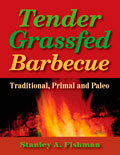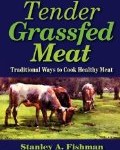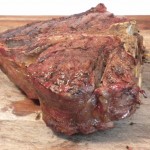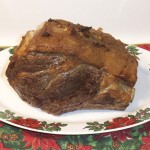Who Was Weston A. Price?
By Stanley A. Fishman, author of Tender Grassfed Meat
Who was Dr. Weston A. Price? He was the man who saved my life and restored my health even though he died before I was born.
Dr. Price was a dentist in Cleveland, Ohio. He was a very distinguished dentist who was also the research director of the American Dental Association. After many years of practice, Dr. Price realized that the teeth and health of his patients were getting worse from year to year. Even more disturbing was the fact that each generation of his patients had worse teeth and was sicker than their parents. Dr. Price decided to find out why.
The Question
After several years of research, Dr. Price decided that the problem was caused by the absence of some essential factors from the modern diet. But he did not know what those factors were. Dr. Price did know that many so-called primitive peoples had excellent teeth. In fact, these “primitives†had much better teeth than the “civilized†peoples who had far superior technology. Dr. Price decided to study those people who had excellent teeth.
The Search
Dr. Price decided to travel directly to where these healthy people lived, so he could study them first-hand and learn why they were healthy. Dr. Price traveled all over the world during the 1920s and early 1930s. He visited isolated, healthy people from Switzerland, the Scottish islands, Australia, Africa, Polynesia, Peru, Native Americans in Canada, and others. He also studied the close relatives of each of these peoples, who were not isolated and lived in more “civilized†circumstances.
The Answer
In every case, Dr. Price learned that the traditional people who ate the diet of their ancestors, which consisted of unprocessed foods, from hunting, gathering, herding, fishing, and natural farming had excellent teeth, without cavities, even though they had no dentists. Not only did these people have excellent teeth, they were free of the chronic diseases that were common in civilization. They did not have cancer. They did not have heart disease. They did not have diabetes. They did not have tuberculosis. They had none of the chronic diseases that plagued the so-called civilized world. They also did not have crime or mental illness. They had no need for police or psychiatrists. Their children were born healthy, without defects. Dr. Price also found that members of the same group of people, when they ate a modern diet, had terrible teeth and were plagued by every one of the chronic diseases that were common in more advanced countries. The only difference was what they ate.
The Solution
Dr. Price discovered that the key to good health is to eat a traditional diet of unprocessed food, and to eat the same kinds of foods that the healthy, isolated people ate. Dr. Price discovered that while the diets of these widely scattered peoples were quite different, they had many elements in common. Dr. Price discovered what these elements were, especially the dietary factors that were essential to good health. He recorded his findings in a book entitled Nutrition and Physical Degeneration, which was published in 1939. This book described exactly what people should and should not eat in order to be healthy.
Ignored and Rediscovered
Unfortunately, Dr. Price’s work was largely ignored. However, his work was preserved by the Price-Pottenger Nutrition Foundation, which devoted itself to keeping his book in print, and keeping his knowledge alive. The Weston A. Price Foundation was founded in 1999. They have done a magnificent job of spreading Dr. Price’s knowledge all over the world and the Internet. Sally Fallon, the founder of the Weston A. Price Foundation, wrote Nourishing Traditions: The Cookbook that Challenges Politically Correct Nutrition and the Diet Dictocrats, a comprehensive cookbook which teaches the reader to cook traditional food that can restore their health. Nourishing Traditions also explains the teachings of Dr. Price in a way that is easy to understand.
How Weston A. Price Saved My Life
I had been chronically ill for most of my life with many illnesses, including life-threatening asthma. I was told in 1998 that I would only get worse, and that my lungs would never heal. Instead of accepting this medical death sentence, I searched desperately for a way to save my life. The website of the Weston A. Price Foundation gave me all the knowledge I needed. I adopted the Weston A. Price diet and became healthy. Once I switched to grassfed meat, I became robustly healthy. If not for Dr. Price, I do not believe I would be here today to write these words.
You can find out more about Dr. Price here.
A Plea for Naturally Fed Pork
By Stanley A. Fishman, author of Tender Grassfed Meat
Why didn’t you include pork in your book? That is the most frequent question I get about Tender Grassfed Meat. The answer is simple. It is very hard to find pork that has enough fat. And it is even harder to find pork that is not fed a substantial amount of soy. Lean pork needs a lot of help or it invariably turns out dry and tasteless. Even with a lot of help, it is hard to do better than mediocre, which is not good enough. Soy fed meat is something I try to avoid. The problems are interrelated, because feeding soy to pigs makes their meat leaner. That said, naturally fed, fat pork is one of the most delicious meats you will ever eat.
The Popularity of Pork
Pork has historically been one of the most popular and widely eaten meats. The ancient Greeks, Romans, and Chinese had one thing in common. They all loved pork, which was their favorite meat. Pork was also the favorite and most widely available meat in Europe, and Polynesia. The Georgians of the Caucasus, a people famed for their longevity, love to eat pork, the fatter the better. Pork was without doubt the favorite meat in America, until the 20th century.
The Natural Diet of Pigs
Pigs are omnivores, who will eat anything. Pigs are forest animals, and their natural diet was based largely on nuts, fruits, and seeds that fell to the forest floor, as well as insects. Pigs used to be raised around forests, which allowed them to feed on the nuts of various trees, such as acorns and beechnuts, (also known as mast). When the forest wasn’t available, pigs were often fed surplus crops, table scraps, and nut crops such as peanuts. Both of these diets made it easy for the pigs to get fat, which gave their meat succulence and kept it from drying out. Pigs fed on mast had a particularly fine flavor, often varying depending on the predominant tree in the area. For example, acorn fed pork had a different flavor from beechnut fed pork. However, pigs fed crops, such as peanuts and apples, also had plenty of fat, and a wonderful flavor based on the crops they were eating. Smithfield hams, which were made from peanut fed pork, were renowned for their fine flavor all over the world. The taste of the pork was heavily influenced by the diet of the pigs.
Soy Rears Its Ugly Head
The wonderful quality of American pork was destroyed by an event and a new kind of feed. The event was the advent of the so-called lipid hypothesis, which claimed that heart disease was caused by eating saturated animal fat. This hypothesis was never proven, but was accepted as fact, first by the manufacturers of vegetable oils and artificial fats, then by the marketing influenced medical profession, then by the government, then by the media, and then by almost everybody else. Since the pork of the time had a good amount of fat, (which is one of the main reasons it tasted so good), pork sales plummeted. The pork industry decided to greatly reduce the fat in pork. They learned that feeding soy to pigs would make the meat much leaner. Soy feed was very cheap. They also bred pigs for leanness. The pork industry succeeded in developing much leaner pork—pork that was so lean that they compared it to chicken breasts. This “success†is the reason that most American pork is lean, dry, tough, and tasteless. It takes a great deal of work to make this pork even mildly tender and tasty.
The Difference
On a very few occasions, I have been lucky enough to eat pork that had the traditional amount of fat, and was not fed soy. This meat was so tender and delicious that it is hard to believe it is even remotely related to soy fed lean pork. I truly believe that soy feeding ruins the taste of pork.
A Request to Farmers
I ask you to make good, fat, naturally fed, soy-free pork available again. I think you will find that there is a great market for this product. There are so many of us that want to get soy out of our diet. If you will make quality pork available, I will recreate recipes for this pork that will do it justice. That’s a promise.
This post is part of Real Food Wednesday Blog Carnival at Kelly the Kitchen Kop.
Cooking Real Food — The Most Important Task

 photo credit: stuartpilbrow
photo credit: stuartpilbrow
By Stanley A. Fishman, author of Tender Grassfed Meat
What if a drug was invented that would reduce the risk of cancer to almost nothing? What if the same drug was just as effective against heart disease? What if this drug also greatly reduced the risk of diabetes, asthma, birth defects, Alzheimer’s, depression, mental illness, ADD, arthritis, obesity, indigestion and every other chronic disease that plagues humankind? What if this very same drug strengthened your immune system to the point that the flu, colds, and infections became a thing of the past? What if the side effects of this drug were limited to a feeling of well-being, boundless energy, peaceful sleep, enhanced mental and physical ability? Wouldn’t you take this drug?
There is no such drug. But you can learn to do something that can provide all of the benefits I have described. You can learn to cook.
The human body is far more complex and intricate than anything invented by human science. There is much about the workings of the human body that is still a mystery. But we do know that the human body has an amazing capacity to protect itself, heal, regenerate, and rebuild. We also know that the body can fail, become very ill, and die.
What is the difference between a healthy body and a sick one?
Dr. Weston A Price, a dentist, noticed that each generation of his patients was less healthy than their parents. He decided to study the effect of diet on humanity, travelling to many countries to learn what healthy people ate. Dr. Price found that people eating the diet of their ancestors were healthy, with none of the chronic diseases that are so common today. These people did not have heart disease. They did not have cancer. They did not have mental illness. They did not have crime. They had no tooth decay, although they had no dentists. When the same people ate modern foods, their teeth decayed, and they suffered from all the chronic illnesses that afflict us today.
When the human body gets all the nutrients it needs, it is healthy. When the body does not get those nutrients, it is sick. Modern foods do not provide all the nutrients needed for good health. Supplements are not the answer, because the body takes its nutrients from foods, including a number of substances in the whole food called cofactors, which are often unknown, and are needed by the body to assimilate nutrients. Supplements do not have all the cofactors. The only way to get all needed nutrients is to eat real, unaltered food, prepared by somebody who knows how to cook it.
The most important task any of us can learn is to cook real food, as this is the only way we can provide the nutrients necessary for health.
Learning what to eat and how to cook takes time and work, but the rewards are worth it. To me, cooking has become more art than work. I truly enjoy it. When I cook, I am always aware that the food I am cooking will become part of me and the people I care about. I cultivate a happy, loving contentment when I cook — knowing that what I am doing will make me and my family healthier, while giving us the pleasure of a delicious meal. I cannot describe how good it feels to become healthier, and to see your family become healthier, and to know it is because of the good food you prepare.
Real cooking may seem difficult at first, but it gets easier and faster over time. If you cook enough, it will become as easy and instinctive as riding a bicycle, or driving a car.
I believe that food must taste good to be truly nutritious. The good taste and smell of real food, properly prepared, gives much pleasure while stimulating the salivary glands. The salivary glands produce substances that aid greatly in the digestion and absorption of food. Good taste helps good nutrition.
Dr. Price discovered what to eat, and what to avoid. I follow the Weston A. Price Foundation’s Dietary Guidelines. I have switched entirely to grassfed and grass finished meat, with wonderful results.
If you have decided to learn to cook real food — the most important task — I recommend the book Nourishing Traditions: The Cookbook that Challenges Politically Correct Nutrition and the Diet Dictocrats by Sally Fallon and Mary G. Enig, PhD. This magnificent book covers just about every aspect of cooking real food, while providing a huge amount of information on what to eat and why. While the scope of the book may seem overwhelming, you don’t have to read the whole thing at once. I recommend using the book as a cooking encyclopedia, and looking up the specific issue or recipe you want to learn about.
For a detailed and user-friendly cookbook on grassfed meat, designed for people who have never cooked grassfed meat, I recommend Tender Grassfed Meat. That is why I wrote it.
This post is part of the Real Food Wednesday blog carnival, hosted this week by Cheeseslave blog. Go see other homages to real foods, good fats on Cheeseslave.com!
Real Foods that Healed Me
By Stanley A. Fishman, author of Tender Grassfed Meat
 I recently wrote a blog that describes in detail the foods that I ate to become healthy, following the recommendations of the Weston A. Price Foundation. Here is a link to the article at Moms for Safe Food.
I recently wrote a blog that describes in detail the foods that I ate to become healthy, following the recommendations of the Weston A. Price Foundation. Here is a link to the article at Moms for Safe Food.
Real Foods that Healed Me
Health Benefits of Grassfed Meat
By Stanley A. Fishman, author of Tender Grassfed Meat
Why did I spend three years writing a book on cooking grassfed meat? Why did I read over 300 cookbooks and novels? The answer is very simple. I wanted to improve my health by enjoying the immense health benefits of grassfed meat. Grassfed meat and fat are so nutritious that they can literally rebuild your body. They certainly rebuilt mine.
Grassfed meat is a completely different product from conventional meat. The natural food of cattle, bison, and lamb is grass and meadow plants. That is all they should be eating. When the animals are raised on grass, their meat is packed full of nutrients in the perfect proportion for good health, in a form that can be easily assimilated by the human body.
Meat that is not 100 percent grassfed and grass finished is fed a mixture of grain, soy, and many other things that were never a part of the natural diet of these animals. The “other things†can include rendered restaurant waste, various animal parts, cement dust, plastic balls, chicken manure, and many other unsavory ingredients. Some producers only feed a 100 percent vegetarian diet to their animals. However, even these diets usually consist of a large amount of grain and soy, which are not part of the natural diet of grass eating animals.
Omega-3 Essential Fatty Acids
The meat of grain finished animals is very different in composition than the meat of grassfed animals, and lacks many of the wonderful nutrients that are present in grassfed meat. For example, the natural balance of omega-6 fatty acids to omega-3 fatty acids should be no more than four to one. In grassfed meat, the ratio is usually one to one. In meat that is not exclusively grassfed, the ratio of omega-6 to omega-3 is often twenty-to-one. The omega-6 excess in the American diet has been associated with a greatly increased risk of cancer, heart disease, obesity, rapid aging, and many other health problems. Many doctors advise their patients to take fish oil capsules to try to help with the imbalance. Grassfed meat has the same ratio of omega-6 to omega-3 as wild fish.
The Benefits of CLA
In addition to having the proper ratio of omega-6 to omega-3 fatty acids, grassfed meat contains a large amount of CLA (Conjugated Linoleic Acid). The amount of CLA goes down when the animal is fed grain. The more grain fed to the animal, the less CLA. Various studies have shown that CLA:
- Increases the metabolic rate
- Increases muscle mass while reducing fat
- Decreases abdominal fat
- Strengthens the immune system
- Reduces the risk of cancer
- Reduces the risk of heart disease
- Reduces the risk of diabetes
- Reduces the risk of hyperthyroidism
- Normalizes thyroid function
More Nutrients in Grassfed Meat
But that is not all. Your body does not use nutrients in isolation, but is accustomed to receiving them together with other substances that are present in the food and necessary for your body to assimilate and use the nutrients. These substances are known as cofactors. When the cofactors are missing or altered, the ability of your body to use the nutrients is greatly reduced. This is why vitamin supplements are often ineffective, because your body needs the cofactors present in real food to properly assimilate nutrients. When you eat 100 percent grassfed and grass finished meat, you know you are getting all the cofactors, in their proper form.
Grassfed meat also provides a wide variety of vitamins, minerals, and amino acids. All of these nutrients are present in proper proportion to each other, along with the cofactors needed for your body to properly assimilate them.
My health has improved enormously since I made the switch to eating only 100 percent grassfed and grass finished meat. Learning how to cook grassfed meat was worth all the time, trouble, and expense. Good health is worth it!
Disclaimer:
I am not a doctor, and the above is not intended to be medical advice. Grassfed meat is a food, not a medicine. By all means, see a doctor if you want medical advice. The above is just a description of my understanding of the nutritional benefits of grassfed meat.
This post is part of GAPS Friendly Friday blog carnival. Read more great Real Food Wednesday blogs at Kelly the Kitchen Cop.
« Previous Page

 Photos of recipes from the new book Tender Grassfed Barbecue
Photos of recipes from the new book Tender Grassfed Barbecue
 Photos of recipes from the cookbook Tender Grassfed Meat
Photos of recipes from the cookbook Tender Grassfed Meat

